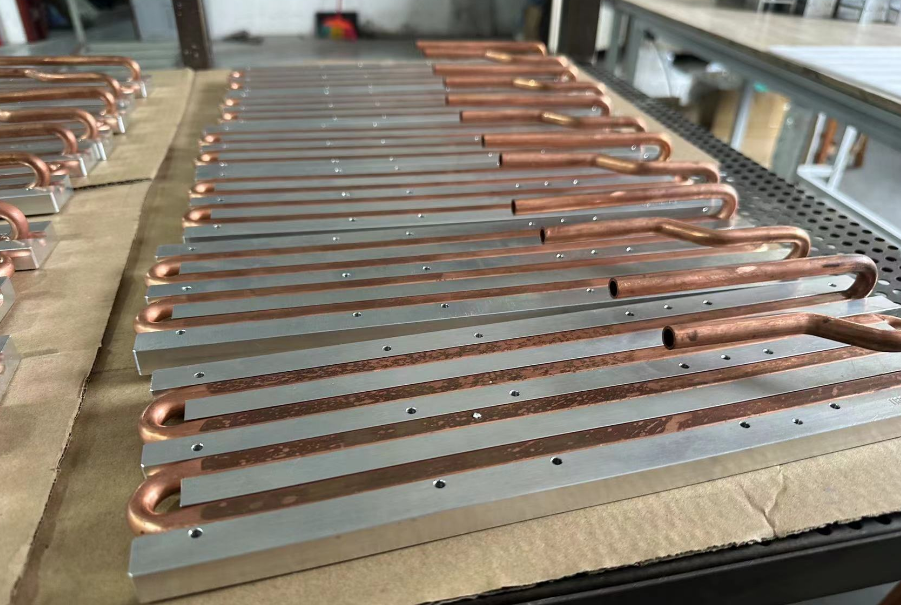With the rapid development of the electronics industry, the application of liquid cooling systems is becoming increasingly widespread. Among them, for liquid cooling plates, the choice of coolant is very importantAt present, there are options in the industry such as ethylene glycol solution, propylene glycol solution, deionized water, etc. Huawei, Dawn, and Hyperfusion mainly use 25% ethylene glycol solution, while Inspur and Xinhua San mainly use 25% propylene glycol solution.
Ethylene glycol solution and propylene glycol solution are industrial standards with high availability, and the cost of ethylene glycol solution is lower than that of propylene glycol solution. The recommended concentration of coolant is between 20% and 30%, and should not be too high as it can affect the heat dissipation performance of the working fluid; It should not be too low, as it can affect the ability to prevent freezing and inhibit microbial growth.

Deionized water has good heat transfer performance, is non-toxic and safe, and can be used as one of the cooling liquids, but attention should be paid to the maintenance of the cooling liquid. The freezing point of deionized water is 0 ℃, and anti freezing issues need to be considered in situations such as transportation, storage, short-term shutdown, low business volume, and servers installed but not running.
Deionized water requires the addition of corrosion inhibitors and bactericides, otherwise it is easy to cause copper corrosion, and long-term use can easily lead to leakage of the copper brazed plate heat exchanger inside the CDU.Cooling fluids require the addition of corrosion inhibitors and fungicides to prevent the growth of bacteria in the pipeline, leading to blockage and leakage.
The coolant of the cold plate liquid cooling technology flows in the cold plate pipeline and does not come into direct contact with electronic devices such as the motherboard and chips. Under the premise of meeting the cooling performance, only the compatibility and reliability between the coolant and the circulation pipeline and the cold plate can be considered.
However, in practical operation, it is necessary to regularly check the coolant to ensure the stable and reliable quality of the cooling medium, in order to reduce risks such as corrosion, accelerated aging, and penetration in long-term working environments. In terms of coolant selection, the commonly used coolants in the secondary cooling circuit of a cold plate liquid cooling system include water-based coolant and non-water-based coolant.

Water based coolant
Water based coolant has good heat transfer performance and can be divided into pure water liquid and formulated liquid.Pure water solution uses pure water as the solvent, without adding any other materials or only adding a certain proportion of ethylene glycol or propylene glycol antifreeze according to antifreeze requirements. Pure water solution suppresses the corrosion of infiltrated materials and the growth of microorganisms by maintaining an ultra-low conductivity environment.
The formula liquid uses pure water as the solvent, and adds a certain proportion of antifreeze according to antifreeze requirements, as well as additives such as corrosion inhibitors and biocides. The formula liquid reduces the corrosion risk of the wetting material and inhibits bacterial growth through additives. Due to the fact that these additives can reduce the thermal conductivity of water and also have the problem of losing their effectiveness due to consumption, regular sampling and monitoring of coolant quality are required during use.
Non aqueous coolant
Non aqueous coolant is mainly divided into hydrocarbons, organosilicon, and fluorocarbon
Compounds require strict review and testing of the compatibility of wetting materials when used.
Hydrocarbon and organosilicon coolants are viscous at room temperature, so they are commonly referred to as “oil coolants” in the industry. Common oil coolants can be divided into natural mineral oil, synthetic oil, organosilicon oil, etc. They generally have common characteristics such as high boiling point, non volatile, non corrosive to metals, environmentally friendly, low toxicity, and low cost. However, due to their flash point, there is a risk of combustible combustion during use. Oil based cooling liquids are generally not used as cooling liquids for cold plate liquid cooling due to their viscosity, viscosity, and susceptibility to moisture absorption and hydrolysis.
Carbon fluorine coolant is a type of organic compound obtained by replacing some or all of the hydrogen contained in hydrocarbons with fluorine. According to the different composition and structure of carbon fluorine compounds, it can be divided into gaseous hydrocarbons (CFC), hydrogen chlorinated hydrocarbons (HCFC), hydrogen hydrocarbons (IFC), perfluorocarbons (PFC), hydrofluoroethanes (IFE), etc. It generally has good electrical insulation and comprehensive heat transfer performance, can achieve non flash point non flammability, strong inertness, and is not easy to react with other substances, making it a good compatible material.
Single/two-phase cold plate liquid cooling
According to whether the cooling liquid in the cold plate liquid cooling system undergoes gas-liquid phase conversion during the absorption or release of heat, it can be divided into single-phase cold plate liquid cooling and two-phase cold plate liquid cooling.
Single phase cold plate liquid cooling absorbs heat through the coolant inside the cold plate, reduces the chip temperature, and does not allow vaporization. Water based coolant, with its high boiling point and good heat transfer performance, becomes an ideal coolant for single-phase cold plate liquid cooling.
Two phase cold plate liquid cooling absorbs heat through the cooling liquid inside the cold plate, and the cooling liquid undergoes gas-liquid phase conversion. Usually, carbon fluorine cooling liquid with lower boiling point and suitable boiling range is selected to facilitate heat absorption vaporization and heat dissipation liquefaction cycle.
The corrosion, deposition, and microbial growth caused by the failure management of the secondary side coolant in cold plate liquid cooling can directly lead to an exponential decrease in heat transfer efficiency, downtime risk, and even server damage.It is generally recommended to use deionized water-based coolant containing anti-corrosion and anti microbial growth functional components, as it has a large specific heat capacity and can meet the heat dissipation needs of high-power processors. Universal to general liquid cooling systems, equally applicable to copper and aluminum liquid cooling plates



